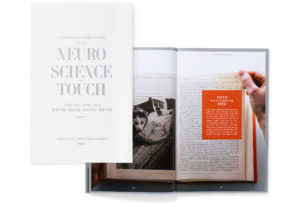The Neuroscience of Touch
 Sappi made a Communicator’s Guide to the Neuroscience of Touch unites neuroscience and branding to explore the many ways touch impacts how people perceive brands.
Sappi made a Communicator’s Guide to the Neuroscience of Touch unites neuroscience and branding to explore the many ways touch impacts how people perceive brands.
Touch—it’s one of the five senses that dictates how we perceive the world around us. It’s also one of the most important. Sappi’s groundbreaking book, written in collaboration with renowned neuroscientist Dr. David Eagleman, dives deeper into haptics, the science of touch. It explores why touch is such a crucial part of the sensory experience and how it influences emotion and decision making, establishing this sense as critical to any brand experience.
Brands that really know how to engage their customers are brands that have mastered the science of touch. They understand how to leverage haptics to create impactful marketing pieces that forge memorable and meaningful connections between brand and customer.
A bird in the hand is worth two in the bush. There’s a reason this popular saying exists—ownership is perceived to add value to a product. This phenomenon is called the endowment effect, and it’s hardwired in the human brain. Take this example: You’ve just won concert tickets. You’ll sell them to your co-worker for no less than $200. If your coworker was trying to sell the same tickets to you, you wouldn’t pay more than $150. You see, the tickets are far more valuable in your hand than they are in your coworker’s. At least, that’s how the endowment effect makes us feel.
Studies have shown that even the simple act of touching objects, like catalogs, brochures and direct mail, can trigger the endowment effect, subconsciously increasing the perceived value of the brand and its products in the eyes of customers.
Touch has power. In fact, one touch can color your impression of a person, place or product. This phenomenon is called incidental touch, and it works like this: Let’s say we’re conducting an interview. If we’re holding a resume printed on heavy, high-quality paper, we’re likely to perceive the candidate as more solid. If the resume is light or flimsy, we’re more likely to view the candidate as less solid and less deserving of the job.
One touch, no matter how fleeting, can significantly influence our judgment of something completely unrelated. The implications here are tremendous—the media we use to showcase our brand has a powerful impact on the way a consumer perceives it.
Not all memories are created equal. Touch has the power to shift the brain into a deeper level of engagement, one more conducive to building lasting knowledge. This has significant implications—touch can make a stronger impact than sight or sound alone. In fact, a number of studies have found that communication through physical media, particularly paper, is more likely to lead to knowledge than communication via digital media.
A recent study performed by the Eagleman Lab took these findings further, discovering that even paper quality makes a difference. In this case, participants were more likely to recall information printed on heavy, high-quality paper than on low-quality paper. First impressions are everything, and touch can help ensure that impression is a good one.
De trainingen voor 2022 staan gereed. Kijk voor het volledige online aanbod van bestaande- en nieuwe trainingen op de website.
BLOKBOEK.COM EN PRINTMEDIANIEUWS: HET OPTIMALE DOELGROEP BEREIK





















